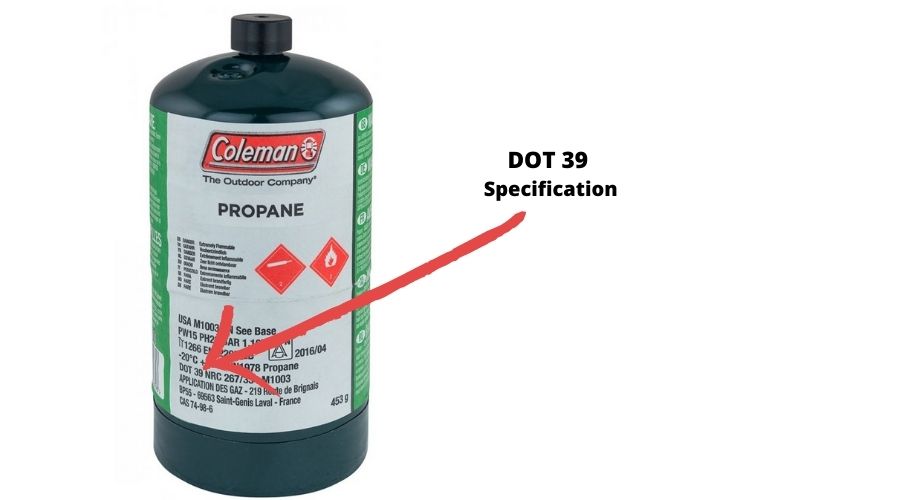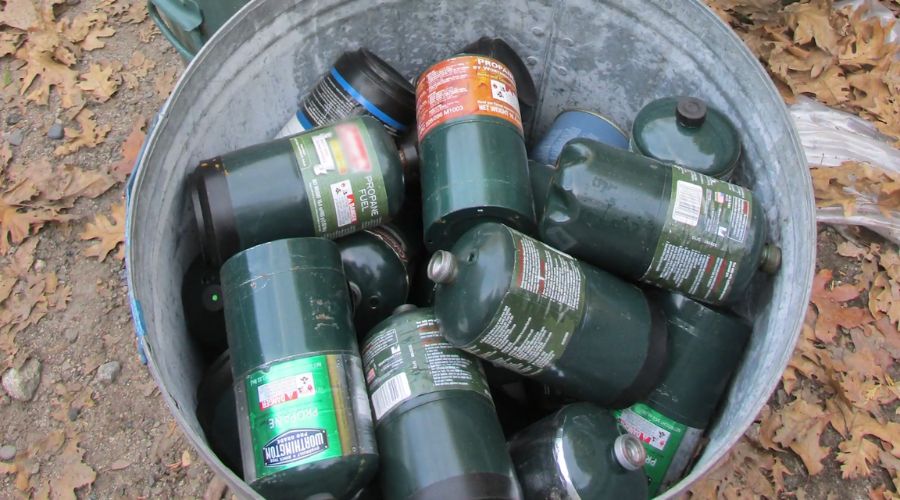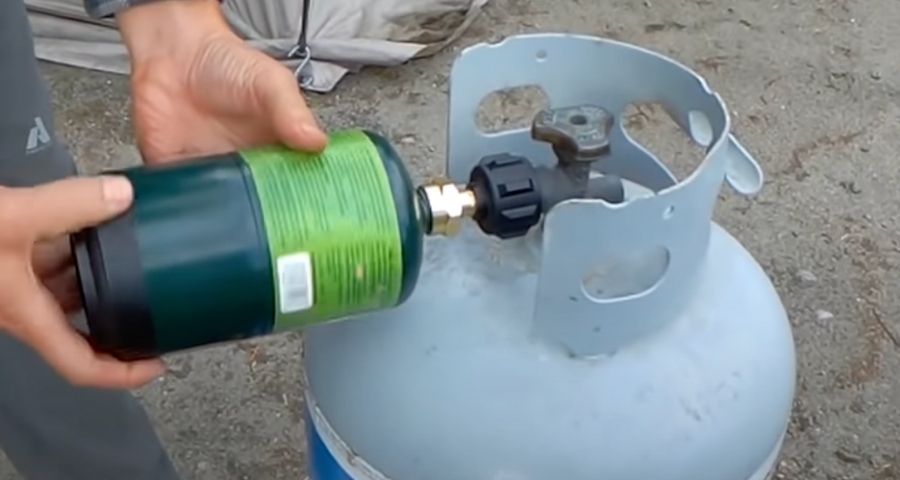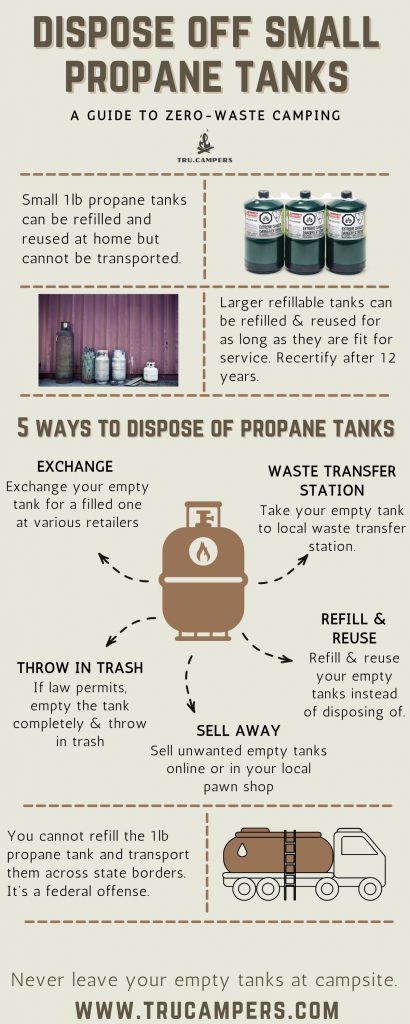This is a guide to disposing of small propane tanks that weigh 20lb or less. These tanks are commonly used for camping and outdoor grilling.
Propane tanks are quite famous among campers. It’s campers’ fuel of choice for cooking, heating, and lighting and is even used as an alternative to campfire.
Most of us have used the small 1lb green color Coleman propane tank on our camping trips. As great as they are, they do contribute to our camping waste and have to be recycled after use.
According to an estimate, 40 million propane cylinders are sold in the US per year. This gives rise to an important question: How to dispose of small propane tanks and cylinders once they are empty?
There are five ways of getting rid of used and empty small propane tanks:
- Exchange them at various retailers like home depot, Lowes, Blue Rhino, etc.
- Recycle them at your local community solid waste transfer station.
- If local laws permit, throw them in the trash for auto-recycling by solid waste department.
- Refill and reuse them (but do not transport them across state lines).
- Sell your used propane tank on Craigslist.
Below, we will look at each of these methods in detail, discuss their pros and cons and see the opportunities and limitations of each.

Remember that a lot of energy has been spent to mine the iron and aluminum used in constructing these cylinders, and it would be a shame to throw them in landfills after using them only once.
That’s why it’s a good idea to recycle propane tanks for as long as possible.
What material is a propane tank made of?
To get a clear understanding of the proper recycling of propane tanks, let’s see what material they are actually made of.
This is important because every material has different properties and is recycled differently.
In the US, all LPG (liquid petroleum gas) cylinders are made according to ASTM or DOT standards.
The small Propane cylinders we use on camping are based on DOT (US Department of Transportation) specifications. The relevant specification is embossed on the metal surface or printed on the label.
For example, the Coleman 16.4oz cylinder is made according to DOT 39 (this number is important for our discussion on refilling below).

All these DOT Propane cylinders are either made from seam welded stainless steel alloy or aluminum.
Both of these materials can be melted and reused and should therefore never go to a landfill or remained buried in your storage room.
Apart from the steel construction of the tank, the gas residues inside make it hazardous waste as per the EPA classification.
Hence, the recycling process is highly specialized and should be handled by hazardous waste experts.
Refillable vs non-refillable tanks
Although refilling and reusing a propane tank is the best course, not all tanks can be refilled.
Most campers either use small 1lb propane tanks (for example, Coleman green tanks) or 20lb large cylinders (mostly RV people). Other sizes are not that popular.
You can not refill the smaller 1lb propane tanks made with DOT39 specifications. By doing so, you would violate the DOT regulation of the transportation of hazardous material.
But that doesn’t mean you can technically not refill them at home. Many campers and outdoorsies refill these small tanks from bigger 20lb tanks quite frequently.
The important thing to note is to refill and NOT transport them across borders.

You violate the DOT regulation only when you transport them, but you can use them at home and at your nearby campsite, and you will be fine.
For the bigger 20lb propane tanks, there is no regulation stopping you from refilling and reusing them over and over again.
The only thing you should care about is the recertification of the tank every 12 years. Every 12 years, you must recertify the tank from a DOT-certified inspector to ensure it is fit for service.
So to summarize the discussion:
- You can refill and reuse the 20lb tanks over and over again.
- You can refill the 1lb tanks and reuse but you cannot transport them across state borders.
Why is propane tank disposal difficult?
Unlike your normal household trash, you cannot just throw your empty Propane canisters in your normal trash. Because of the gas residue inside, these tanks are a possible explosion hazard.
Recycling trucks often compress collected trash using hydraulic compressors to make room for more trash before transporting them to the waste management facility.
If any propane tank has leftover gas inside, it can cause an explosion causing damage to material and even the personnel handling the trash.
That’s the reason most waste management companies are wary of these tanks and will refuse to collect them. They can’t make sure that each tank is completely empty, so it’s easier for them to just not collect them.
Coleman tried to solve the propane tank disposal issue by introducing the Green Key®️ tool (more on this below) but it has yet to see a wide adaptation and recognition.
To properly recycle propane tanks, you have to be very considerate about how and where it ends up.
How to dispose of propane tanks (safe & legal)
As discussed above, there are 4 ways you can safely and legally dispose of small propane canisters used for camping and outdoor grilling.
Knowing where and how to dispose of propane tanks should be part of your clean camping obligation.
1. Exchange them at various retailers
A 16.4 oz propane tank lasts for 2 hours on camping stoves and becomes recyclable trash afterward. As per DOT regulations, you cannot refill and transport them across state borders.
But you can refill and reuse them at home or at your nearby campsite. You can easily refill them from a bigger propane tank using an adaptor.
The bigger 20lb can be used for a longer period but can be refilled and exchanged. You can exchange your refillable empty Propane gas cylinder for a filled one from a number of retailers.

You only have to pay for the gas inside. To avail of this, you will have to make sure that the cylinder you are exchanging is fit for service and has no damages.
Most of these gas retailers accept all brands. You don’t have to exchange your cylinder from the same brand. This makes things quite easy.
For example, you can exchange a Coleman cylinder at RapidXchange and take a filled RapidXchange cylinder.
The below list covers some of the notable retailers in the US where you can exchange your empty propane tank.
- RapidXchange: You can turn old propane tanks at RapidXchange station and get a filled one. They cover most of the states, and you can actually search your nearest RapidXchange station on their website. To learn more about their program and how it works, go to the RapidXchange website.
- Lakes Gas: If you live in the upper midwest (Michigan, Wisconsin, Minnesota, or South Dakota), you can exchange your empty propane cylinder at any nearest Lakes gas station and get a new one. You can find your nearest location by searching your zip code here.
- AmeriGas: AmeriGas also has a propane tank exchange program. They have partnered with 3rd party retailers (gas stations, hardware stores, convenience stores, etc.) to expand their nationwide reach. You can take your empty tank to any of these locations and pick up a new cylinder. Do note that not all stations exchange empty tanks (the majority of them do but not all). To see the nearest locations that accept old tanks, go to this page and enter your zip code and then apply the filter on the right side that says “Propane Tank Exchange”.
- Blue Rhino: You can drop your empty propane tank at Blue Rhino station and pick up a new tank. Like most retailers, you can exchange any other brand for Blue Rhino without any problem. The only caveat is that your tank must be in acceptable condition. To find your nearest Blue Rhino station, you can text FIND to 75653 or visit this link to search with your area zip code.
- Walmart: You can exchange your empty tank at most Walmart stores as well. They accept Blue Rhino, AmeriGas, Flame King, Backyard Grill, and other brands easily and will give you a filled tank for a lower price.
- Home Depot: Just like Walmart, Home Depot also accepts all brands of empty propane tanks and will give you a new, filled one.
2. Dispose of at the waste transfer stations
You can dispose of your tank at your nearest community waster transfer station if:
- If it’s not refillable (e-g, small 1lb tanks)
- It is damaged beyond an exchange.
- You don’t need it anymore.
Most counties have their own waste management facilities where you can get rid of any hazardous waste, including your propane tanks, for a small fee. You can google “propane tank disposal near me” and get a list of locations.
The fee varies by location, and this fee goes to maintaining the landfill sites and recycling facilities.
The old tanks are properly handled by hazardous waste experts and recycled to make something else from the material.
Below is a very interesting video about the working of Miramar Landfill & Greenery in San Diego to understand how the trash (including your propane tanks) is received, processed, and disposed of/recycled in one of the nation’s largest landfills.
By turning in your old recyclable propane tanks to your nearest waste management facility, you are making sure that it does not end up in any landfill.
It will be recycled and used to make something new (perhaps a new propane tank).
Bernzomatic has a dedicated page to find your nearest waste management facility using your zip code. It’s pretty helpful and can tell you exactly where to take empty propane tanks for recycling.
3. Completely empty & throw in the trash
If your local laws don’t say anything about trashing used fuel tanks, you can empty the tank completely and trash it with your household waste.
But your waste pickup company may have problems with handling empty tanks. The reason is, that they don’t know if it is empty or not, and they can’t make sure if it is.
To solve this problem and give waste pick-up company personnel some confidence, Coleman introduced their Green Key Tool back in 2008.
It is basically a small plastic key that goes into the nozzle of one-time-use propane canisters and makes sure the tank drains completely.

The concept behind this was that when a waste pick-up personnel sees the Green Key, he can confidently pick up the canister without fearing an explosion during compaction.
So far, it hasn’t been that widely adapted and accepted.
Before you trash your old propane tank, you have to make sure your local laws permit it and that the tank is completely empty.
To remove any residue of leftover gases inside, follow the below steps:
- Take your propane cylinder to an open space and connect it to any appliance. A single-burner camping stove head is a good option.
- Turn on the burner, ignite the flame, and let it burn till the pressure drops and the flame goes out.
- Wait for a few minutes to let any residual gas escape.
- Now, disconnect your propane tank and insert your Green Key tool (you can buy them here if you don’t have one).
- Keep the key inserted permanently to dispose of the cylinder.
The bright green-colored key on top of the nozzle is an indicator for waste collection agencies that the container is completely empty of all traces of propane and is safe to crush and recycle.
4. Refill & Reuse
⚠️ DOT 39 Cylinders are not designed to be refilled. Refilling them can be dangerous to life and property.
All those small 1lb propane tanks we take camping are DOT-39 cylinders. You can check the certification number on the back of these cylinders. They are designed for one-time use and should not be refilled.
Refilling and transportation of all cylinders marked “DOT 39” are a federal violation and can have a penalty of $500,000 and 5 years in prison as per 49 CFR § 178.65

But as discussed above, many people refill and reuse these Coleman propane tanks at home (transportation across state borders is prohibited). But before you refill, make sure:
- Check the cylinder for rust, dents, and any other physical damage that can compromise its integrity.
- Check the sealing inside the plug-in valve. Make sure it’s not brittle, cracked, or missing.
- Check the valve threads and see if they are sharp. Worn-out threads cause loose connections and leaks.
- After filling, check for any gas leaks using the bubble soap test.
But larger 5lb and 20lb cylinders have no restrictions on refilling, you can refill them yourself or from any certified refilling station and use them for a long time.
Each cylinder has a certain time period, after which it must be recertified for service. The last certification date and the next time period are stamped on the metal service.
If you are not sure, you can ask your local filling station, and they can guide you.

Refilling a single cylinder multiple times makes them very economical because each time you refill, you are only paying for the gas and not the steel cylinder.
However, make sure the cylinder is in good condition and has no rusting or deformation. Else it can be an explosion hazard. Propane tank explosions are very disastrous.
5. Sell your unwanted tanks on Craiglist
A lot of people are looking for used propane tanks for sale. If your tank is in good enough condition and can be refilled and reused, you can list them on Craiglist for a price and sell them.
The person buying it can put it to better use. If a cylinder is used to its full extent instead of recycling after a few uses, that saves a lot of energy that goes into making a new cylinder.
Many people who buys empty propane tanks and other used household items usually surf craigslist for cheap deals and you can get rid of your used propane tanks in no time.
The below infographics summarise the 5 ways to dispose of or reuse empty propane tanks.

How to dispose of small propane tanks? – Conclusion
Propane tanks are a very versatile energy source for camping. They can be used in all seasons to heat your tent or cook your food and can power a variety of equipment like camping stoves, open flame heaters, or even catalytic heaters but propane tank disposal is a tricky job.
Not all tanks can be refilled so you have to dispose them of at some point. Disposal of propane tanks requires much more consideration than your average household waste.
They are Household Hazardous Waste (HHW) and need proper handling.
Following the 5 different methods explained above, you can dispose of or even reuse your empty propane tanks safely and legally.
FAQs
How to tell if propane tank is empty?
Pour a glass of warm water over the tank surface from top to bottom. Put your hand on top of the tank surface and slowly move down, feeling the temperature of the metal surface. If the metal surface is uniformly hot from top to bottom, it is empty. If it is colder at the bottom, it still has gas in it.
u003cmeta charset=u0022utf-8u0022u003eHow do I recertify my propane tank?
You can recertify your propane tank from any DOT-authorized inspector. You can find recertification experts on all Propane tank stations like AmeriGas, Blue Rhino, etc.
u003cmeta charset=u0022utf-8u0022u003eHow much does it cost to recertify a propane cylinder?
Recertification of propane tanks costs anywhere from $35 to $60 depending upon the person doing the job. Call a few experts around your area and take a hint at the current cost.
u003cmeta charset=u0022utf-8u0022u003eDo 1lb propane cylinders expire?
An unopened Propane cylinder can last indefinitely. The propane gas inside does not break down but it is possible for the rubber sealing of the valve to degrade and leak propane slowly over time.
Can you get money for old propane tanks?
Yes, old propane tanks can be easily sold online as well as in old hardware shops. Depending on their condition, they can fetch you good money.
Where can I return propane tanks?
You can return your unwanted propane tanks to retailers across the US. You can either get money or a filled tank if you want (you only pay for the gas inside)
How to dispose of Coleman propane tanks?
Coleman 1lb propane tanks can be used once and disposed of via your local waste transfer station. If you have a Coleman Green Key, you can use it and throw the tank in the trash too.
Recommended Camping Gears: I have compiled a list of my favourite camping gear in one place. The selection is based on my own personal experience using them for many years camping as well as feedback from fellow campers. Check them out on my Recommended Camping Gears page